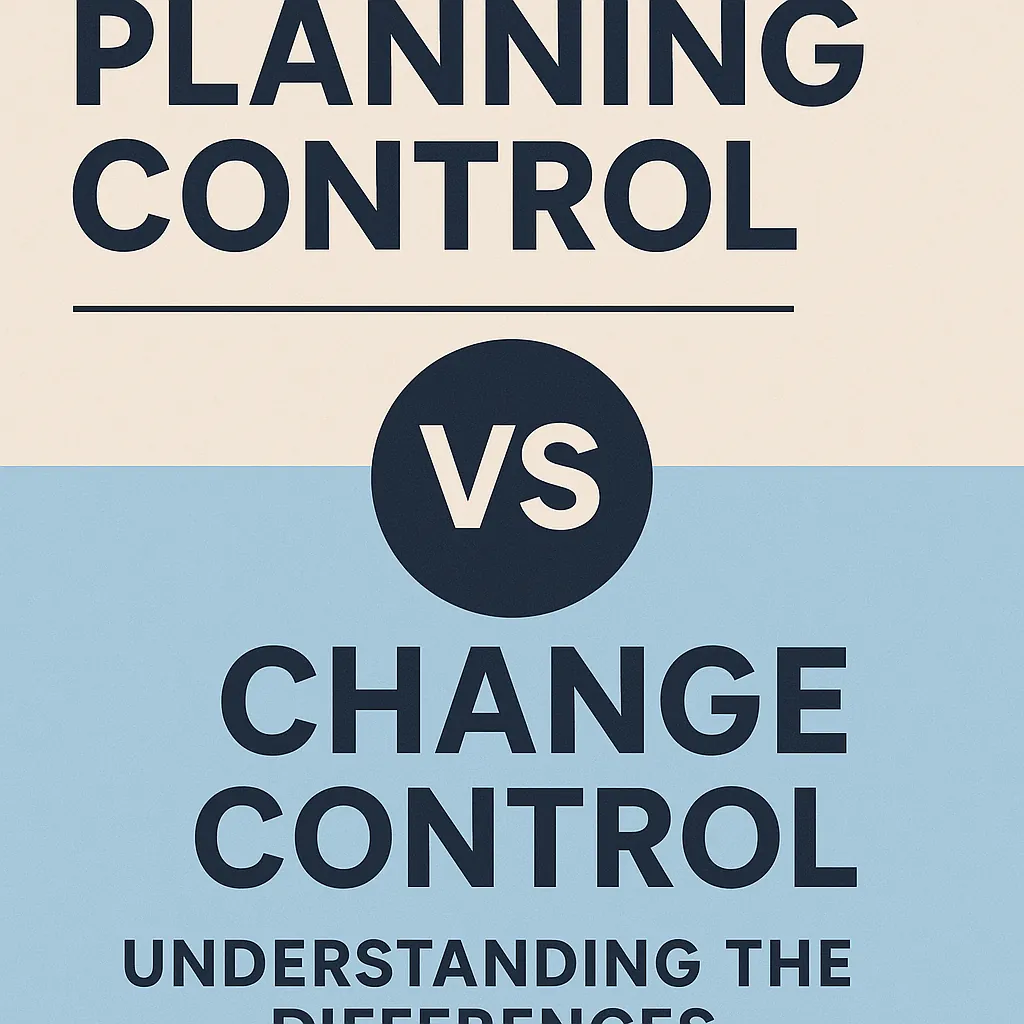Introduction
Effective control mechanisms are essential for ensuring that projects are delivered on time, within scope, and on budget. Two critical concepts in this domain are planning control and change control. Understanding these concepts and their interrelationships is vital for project managers and process improvement specialists aiming to enhance project outcomes.
Planning Control refers to the systematic approach of establishing project objectives, timelines, and baselines for cost and scope. It involves a series of steps that guide project managers from problem identification to decision implementation, ensuring that the project remains aligned with its goals throughout its lifecycle. This process is crucial as it lays the groundwork for project execution, allowing for the identification of deviations and the initiation of corrective actions when necessary [10][13].
On the other hand, Change Control is a structured process that manages and regulates changes to the project plan, schedule, and budget. It is designed to minimize the risks associated with changes, ensuring that any modifications are carefully evaluated and approved before implementation. This process is essential for maintaining project integrity and preventing scope creep, which can derail project objectives [1][9].
The significance of both planning control and change control cannot be overstated. Effective planning control provides a solid foundation for project execution, while robust change control mechanisms ensure that any necessary adjustments are made in a controlled manner. Together, they contribute to project success by fostering a proactive approach to managing both the initial plan and any changes that may arise during the project lifecycle.
The purpose of this post is to clarify the distinctions and interdependencies between planning control and change control. By exploring these concepts in detail, we aim to equip project managers and process improvement specialists with the knowledge needed to implement effective control strategies that enhance project performance and outcomes.
What is Planning Control?
Planning control is a critical aspect of project management that involves the systematic process of defining, monitoring, and adjusting project plans to ensure successful project delivery. It serves as a navigational tool for project managers, enabling them to maintain oversight of various project elements and ensure that the project remains on track to meet its objectives.
Definition and Role in Project Management
Planning control can be defined as the framework through which project managers establish project goals, allocate resources, and set timelines while continuously monitoring progress against these plans. Its primary role is to ensure that all project activities align with the defined objectives, thereby facilitating effective decision-making and resource management throughout the project lifecycle. By implementing planning control, project managers can proactively identify potential issues and make necessary adjustments before they escalate into significant problems [1][12].
Key Components of Planning Control
The effectiveness of planning control hinges on several key components:
- Scope Management: Clearly defining what is included and excluded in the project helps manage stakeholder expectations and provides a framework for planning. This clarity is essential for avoiding scope creep, which can derail project timelines and budgets [10].
- Resource Allocation: Identifying and assigning the right resources—human, financial, and material—ensures that the project has the capacity to proceed as planned. Effective resource management is crucial for maintaining project momentum and achieving desired outcomes [10].
- Timelines: Establishing realistic timelines is vital for tracking progress and ensuring that project milestones are met. This involves creating a detailed schedule that outlines when tasks should be completed and how they interrelate [12].
- Budgeting: A well-defined project budget is essential for effective cost control. It allows project managers to monitor expenditures and make informed decisions about resource allocation, ensuring that the project remains financially viable [11].
Achieving Project Objectives and Maintaining Alignment
Planning control plays a pivotal role in achieving project objectives by providing a structured approach to project management. It enables project managers to:
- Monitor Progress: By regularly reviewing project performance against the established plans, project managers can identify deviations and take corrective actions as needed. This ongoing assessment helps ensure that the project stays aligned with its goals [12].
- Facilitate Communication: Effective planning control fosters clear communication among stakeholders, ensuring that everyone is aware of project status, changes, and expectations. This transparency is crucial for maintaining stakeholder engagement and support [14].
- Enhance Decision-Making: With a comprehensive understanding of project plans and performance metrics, project managers can make informed decisions that enhance project outcomes. This capability is particularly important in dynamic environments where changes may be necessary [12].
What is Change Control?
Change control is a systematic approach to managing alterations in a project’s scope, objectives, or deliverables. It is a critical component of project management frameworks, ensuring that any changes are carefully considered and implemented without jeopardizing the project’s overall success. The primary purpose of change control is to maintain project integrity by minimizing disruptions and ensuring that all stakeholders are aligned with the project’s evolving requirements.
Key Aspects of Change Control:
- Definition and Purpose: Change control refers to the processes and procedures that project managers use to manage changes in a project. It aims to ensure that any modifications are made in a controlled manner, allowing for proper assessment of their impact on the project’s timeline, budget, and quality. This structured approach helps prevent scope creep, which can lead to project delays and increased costs [3][6].
Change Control Process: The change control process typically involves several key steps:
- Identification: Recognizing the need for a change, which can arise from various sources such as stakeholder requests, unforeseen circumstances, or new regulatory requirements.
- Evaluation: Assessing the potential impact of the proposed change on the project’s scope, schedule, and resources. This step often involves consulting with team members and stakeholders to gather insights and data.
- Approval: Gaining formal approval from relevant stakeholders or a change control board. This ensures that all parties are aware of and agree to the proposed changes before they are implemented.
- Implementation: Executing the approved changes while ensuring that all project documentation is updated accordingly. This step may also involve communicating the changes to the project team and stakeholders to ensure everyone is on the same page [10][11].
- Importance of Effective Change Management: Managing changes effectively is crucial for minimizing disruptions to project plans. When changes are not controlled, they can lead to confusion, miscommunication, and a lack of alignment among team members. By implementing a robust change control process, project managers can ensure that changes are made thoughtfully and strategically, thereby preserving the project’s objectives and maintaining stakeholder confidence [3][4][10].
Key Differences Between Planning Control and Change Control
Understanding the distinctions between planning control and change control is crucial for effective project execution and success. Both concepts play significant roles but address different aspects of project management. Here’s a detailed comparison to clarify their objectives, functions, and interdependencies.
Objectives
- Planning Control: The primary objective of planning control is to ensure that a project adheres to its original plan. This involves monitoring project progress against the established schedule, budget, and scope. The goal is to identify any deviations from the plan early on and implement corrective actions to keep the project on track. Planning control focuses on maintaining the integrity of the project plan throughout its lifecycle.
- Change Control: In contrast, change control is concerned with managing any alterations to the project’s baseline. This includes evaluating, approving, or rejecting changes that may arise due to unforeseen circumstances or new requirements. The objective of change control is to systematically handle changes to minimize disruption and ensure that all stakeholders are informed and aligned with the new direction of the project.
Addressing Different Aspects of Project Management
- Planning Control: This control mechanism primarily deals with the proactive aspects of project management. It involves setting clear objectives, defining deliverables, and establishing timelines. Project managers utilize planning control to track progress, assess performance metrics, and ensure that resources are allocated efficiently. It is about adhering to the plan and making adjustments as necessary to avoid deviations.
- Change Control: Change control, on the other hand, is reactive. It comes into play when there are requests for changes that could impact the project’s baseline. This process involves a formalized approach to assess the implications of proposed changes, including their impact on scope, schedule, and budget. Change control ensures that any modifications are documented, evaluated, and communicated effectively to all stakeholders.
Interdependencies and Examples
The relationship between planning control and change control is interdependent. Changes in project scope or objectives often arise from the planning control process. For instance:
- Example of Planning Control Leading to Change Control: During a project’s execution, a project manager may identify that certain tasks are taking longer than anticipated due to resource constraints. In response, they may decide to adjust the project timeline or reallocate resources. This adjustment, while necessary for maintaining project integrity, may require formal change control procedures to document the new timeline and communicate it to stakeholders.
- Example of Change Control Impacting Planning Control: Conversely, if a client requests additional features after the project has commenced, this change will necessitate a change control process to evaluate the request. If approved, the project plan will need to be updated to reflect the new scope, which may also affect timelines and resource allocation, thus impacting planning control.
Interdependencies Between Planning Control and Change Control
Understanding the relationship between planning control and change control is crucial for ensuring project success. Both processes are interrelated and play significant roles in managing project dynamics effectively. Here are some key points that elucidate their interdependencies:
- Cyclical Nature of Planning and Change: Planning control and change control operate in a cyclical manner. As projects progress, initial plans may need adjustments due to unforeseen circumstances or new information. This cycle involves identifying problems, defining them, gathering data, and implementing decisions, which is a fundamental aspect of the planning control cycle [9]. When changes occur, they often trigger a reassessment of the project plan, leading to a continuous loop of planning and adjustment.
- Effective Planning Reduces Change Control Needs: A well-structured planning phase can significantly minimize the necessity for change control later in the project lifecycle. By outlining clear objectives, deliverables, and constraints from the outset, project managers can anticipate potential issues and address them proactively. This foresight helps in aligning project execution with the original plan, thereby reducing the likelihood of deviations that would require formal change control processes [7]. The more detailed and comprehensive the planning, the less reactive management is needed, which streamlines project execution.
- Change Control Necessitating Updates to Planning Control: There are scenarios where change control directly impacts planning control. For instance, when a change request is approved, it may alter the project scope, timeline, or resources, necessitating updates to the project plan [12]. This could involve revising key deliverables, adjusting timelines, or reallocating resources to accommodate the changes. Such updates ensure that the project remains aligned with its objectives and constraints, maintaining coherence between what was planned and what is being executed [6].
Best Practices for Integrating Planning Control and Change Control
Maintaining a seamless integration between planning control and change control is crucial for ensuring project success. Both processes serve distinct purposes but are interdependent, and understanding their differences can enhance overall project performance. Here are some best practices for project managers to effectively utilize both controls:
1. Maintain Alignment Between Planning and Change Control Processes
- Establish Clear Objectives: Begin by defining clear project objectives that align with both planning and change control. This ensures that any changes made during the project lifecycle are in line with the overall goals and do not derail the project’s direction [1].
- Regular Review Meetings: Schedule regular meetings to review both planning and change control processes. This allows for timely identification of any discrepancies and ensures that all team members are on the same page regarding project status and changes [2].
- Integrated Change Control Process: Implement an integrated change control process that incorporates feedback from planning activities. This helps in assessing the impact of changes on the project plan and facilitates informed decision-making [3].
2. Importance of Documentation and Communication
- Thorough Documentation: Maintain comprehensive documentation for both planning and change control processes. This includes documenting change requests, approvals, and the rationale behind changes, as well as updates to the project plan. Proper documentation serves as a reference point and aids in accountability [4].
- Effective Communication Channels: Establish clear communication channels among stakeholders. Regular updates and open lines of communication help in managing expectations and ensuring that everyone is aware of changes and their implications on the project [5].
- Change Logs: Utilize change logs to track all modifications made during the project. This not only provides a historical record but also helps in analyzing the impact of changes on project performance [6].
3. Tools and Methodologies for Integration
- Agile Practices: Consider adopting Agile methodologies, which emphasize flexibility and iterative progress. Agile practices facilitate quick adjustments to project plans in response to changes, allowing for a more dynamic integration of planning and change control [7].
- Project Management Software: Leverage project management tools that support both planning and change control functionalities. These tools can help in visualizing project timelines, tracking changes, and managing resources effectively [8].
- Stakeholder Engagement Tools: Use stakeholder engagement tools to gather input and feedback throughout the project lifecycle. Engaging stakeholders in both planning and change control processes ensures that their perspectives are considered, leading to better decision-making [9].
By implementing these best practices, project managers can create a cohesive framework that effectively integrates planning control and change control. This not only enhances project efficiency but also fosters a culture of adaptability and continuous improvement within the project team.
Case Studies: Real-World Applications
Understanding the distinctions and interdependencies between planning control and change control is crucial for achieving successful project outcomes. This section presents concrete examples that illustrate how effective planning control can lead to project success, while poor change control can result in significant challenges.
Effective Planning Control Leading to Success
- Sydney Opera House Project: The construction of the Sydney Opera House is a classic example of effective planning control. The project managers developed comprehensive project plans that outlined necessary tasks, timelines, and resources, which were crucial for managing the complexity of this iconic structure. The meticulous planning allowed for better resource allocation and adherence to timelines, ultimately leading to the successful completion of the project, despite its initial challenges [6].
- Airbus Supply Chain Management: Airbus implemented robust project management strategies, including strong planning control mechanisms, to streamline their supply chain. By closely collaborating with suppliers and establishing clear timelines and expectations, Airbus ensured the timely delivery of critical components. This proactive approach to planning control helped mitigate risks associated with supply chain disruptions, resulting in smoother project execution and enhanced operational efficiency [1].
Poor Change Control Resulting in Challenges
- Denver International Airport Baggage Handling System: The Denver International Airport project faced significant challenges due to inadequate change control processes. Originally, the project included an ambitious automated baggage handling system. However, as changes were made to the design and scope without proper change control, the project experienced delays and cost overruns. The lack of a systematic approach to managing changes led to confusion among stakeholders and ultimately resulted in the abandonment of the automated system, highlighting the critical need for effective change control [8].
- NASA’s Mars Climate Orbiter: The Mars Climate Orbiter mission serves as a cautionary tale regarding poor change control. A failure to maintain consistent units of measurement between teams led to the spacecraft’s loss upon entering Mars’ atmosphere. This incident underscores the importance of rigorous change control processes to ensure that all project changes are documented, communicated, and understood by all stakeholders, thereby preventing costly mistakes [8].
Lessons Learned
- Importance of Planning Control: The case studies demonstrate that effective planning control is essential for setting clear objectives, timelines, and resource allocations. Projects like the Sydney Opera House and Airbus’s supply chain management illustrate how thorough planning can lead to successful outcomes and mitigate risks.
- Critical Role of Change Control: Conversely, the challenges faced by the Denver International Airport and NASA’s Mars Climate Orbiter highlight the dire consequences of poor change control. These examples reinforce the necessity of having a systematic approach to managing changes, ensuring that all stakeholders are aligned and informed.
- Interdependency of Controls: Ultimately, both planning control and change control are interdependent. Effective planning lays the groundwork for successful project execution, while robust change control processes ensure that any necessary adjustments are managed without derailing the project. Project managers and process improvement specialists must recognize and implement both controls to enhance project success rates and minimize risks.
By analyzing these real-world applications, project managers can gain valuable insights into the importance of both planning and change control, equipping them with the knowledge to navigate the complexities of project management effectively.
Conclusion
Understanding the distinctions and interdependencies between planning control and change control is crucial for successful project execution.
- Definitions and Roles: Planning control refers to the systematic approach of monitoring and regulating project performance to ensure alignment with the objectives and constraints established during the planning phase. It encompasses the creation of baselines for schedule, cost, and scope, and focuses on measuring key performance indicators (KPIs) to maintain project direction and integrity [11][14]. On the other hand, change control is a structured process that manages alterations to the project scope, resources, or processes, ensuring that any changes are made in a controlled manner to minimize risks and disruptions [1][2].
- Recognizing Differences and Interdependencies: While planning control is primarily concerned with adhering to the original project plan, change control addresses the need for flexibility in response to unforeseen circumstances or stakeholder requests. It is essential for project managers to recognize that these two controls are not mutually exclusive; rather, they complement each other. Effective planning control provides a solid foundation for managing changes, while robust change control processes can inform and refine planning efforts as projects evolve [10][13].
- Adopting Best Practices: To enhance project outcomes, project managers should adopt best practices that integrate both planning and change control. This includes establishing clear communication channels, setting realistic baselines, and implementing regular reviews to assess project performance against the plan. By fostering a culture of adaptability and continuous improvement, project managers can navigate the complexities of project execution more effectively, ensuring that both planned objectives and necessary changes are managed harmoniously [7][12].
In summary, a comprehensive understanding of planning control and change control is vital for project managers and process improvement specialists. By recognizing their unique roles and interdependencies, and by implementing best practices, project teams can achieve greater success in delivering projects on time, within budget, and to the desired quality standards.
Find out more about Shaun Stoltz https://www.shaunstoltz.com/about/.
This post was written by an AI and reviewed/edited by a human.



